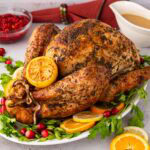
Best Roasted Turkey Recipe
This is the BEST Thanksgiving Turkey Recipe, packed with all the flavor and juiciness you crave—without any of the stress! I’ve got you covered with an easy, step-by-step guide to roasting a turkey that turns out perfectly every time.
Servings: 10 servings
Ingredients
- 12- 14 pound fresh or frozen turkey thawed
Turkey Rub
- 1 Tablespoon kosher salt
- 2 teaspoons seasoned salt
- 1 teaspoon ground pepper
- 1 teaspoon poultry seasoning
- 1 teaspoon garlic powder
- 1 teaspoon paprika
- 1 teaspoon ground red pepper cayenne pepper, optional or to taste
- 1 teaspoon dried basil
- 1 teaspoon dried parsley
- 1 stick of butter softened
Optional Ingredients
- 1 - 2 lemons quartered and placed inside cavity
- 1 large onion quartered and placed inside cavity
Instructions
- If the turkey is frozen: Thaw in the fridge, 24 hours for every 5 pounds of Turkey. I like to give myself 1 extra day, just to be safe.
- Remove the thawed turkey from the fridge approximately 1 hour before roasting, to let it come to room temperature.
- Adjust your oven rack so the turkey will sit in the center of the oven. Preheat the oven to 325 degrees F.
- Remove the turkey from the packaging and remove the neck and giblets from the inside of the cavity of the bird. (Reserve them for gravy, if desired, or discard them). Drain the juices and pat the turkey dry with paper towels.
- Mix the seasonings together.
- Tie the legs together with heavy kitchen string. Lift the wing tips up and over the back; tuck under the turkey. Set turkey on the rack in a roasting pan.
- Use your fingers to separate the skin from the breast meat, starting at the top of the breast and sliding to the right and left, then working down. Massage ⅓ of the rub onto the meat under the skin.
- Microwave the butter for 30 seconds (it doesn’t need to be completely melted, just really softened). Mix the remaining seasoning with the butter. Use a basting brush to brush the remaining seasoned butter all over the outside of the turkey, legs, and wings.(This can also be done by mixing seasoning into softened butter and spreading on by hand)
- Insert an oven-safe meat thermometer deep into the lower part of the thigh without touching the bone.
- Roast at 325 degrees F for about 15-18 minutes per pound or until the internal temperature inserted into the thickest part of the thigh reaches about 165℉.
- Check the turkey about halfway through cooking, and once the skin gets desired golden brown, cover the top of the turkey with foil, to protect the breast meat from overcooking.
- Transfer the turkey to a platter to rest for 20 to 30 minutes before carving.
- Reserve any juices and drippings in the roasting pan to make turkey gravy.
Notes
Turkey Roasting Tips
- Don’t Baste the Turkey: Basting requires opening the oven often, which lowers the temperature and increases cooking time. Rub the turkey with herb butter instead for a juicy, crispy skin without the hassle.
- Don’t Stuff the Turkey: Cooking stuffing inside extends the turkey’s cooking time, potentially drying out the meat. Make the stuffing separately to ensure both the turkey and stuffing cook evenly.
- No need to Brine the Turkey. For this simpler method, skip the brine and use our flavorful seasoned herb butter rub on the skin and under it for moisture and flavor without the extra step of brining.
- Covering with Foil: Start by roasting the turkey uncovered. Once the skin turns golden brown, loosely tent it with foil to prevent over-browning and over-cooking the breast meat. If you have a roasting pan with a lid, you can use that instead.
- Test with a Thermometer: To prevent overcooking, use a meat probe thermometer or an instant-read thermometer to check the internal temperature. The thickest part of the thigh should reach 165°F, ensuring safe and juicy meat. I know most turkeys have a probe that pops out, and if you don't have a thermometer, you can use this, but I still like to use my thermometer to test it.
- Let the Turkey Rest: After cooking, let the turkey rest for at least 20-30 minutes. This allows the juices to redistribute, keeping the meat moist and tender.
- Save Turkey Drippings for Gravy: The flavorful drippings in the roasting pan are perfect for making a rich, savory turkey gravy. Strain the drippings, make a roux, and whisk in broth for an easy, delicious gravy.
Nutrition
Serving: 1serving | Calories: 445kcal | Carbohydrates: 2g | Protein: 88g | Fat: 8g | Saturated Fat: 2g | Polyunsaturated Fat: 2g | Monounsaturated Fat: 2g | Trans Fat: 0.03g | Cholesterol: 261mg | Sodium: 1291mg | Potassium: 954mg | Fiber: 1g | Sugar: 1g | Vitamin A: 255IU | Vitamin C: 5mg | Calcium: 52mg | Iron: 4mg
Find it online:
www.soulfullymade.com/roasted-turkey-recipe/